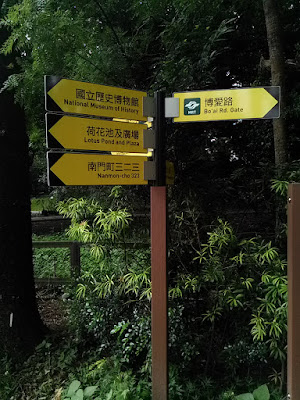After an over one month long break, we resumed our nature class outings.
At this time of the year the purple flowers of the melastoma plant (Melastoma candidum, 野牡丹) have already withered.
First one took us back to the Taipei Botanical Garden.
You can read about our previous visits to the garden in the following posts:
Unfortunately this time I forgot to take my camera! So the only photos I have I took with my phone (which is not the best for taking pictures).
Each visit to the Botanical Garden brings new discoveries. We visit the garden at different times of the year, go to different parts of the garden and talk about different plants. And even if the kids have already heard something once a few months ago it's a good way to review what they have learned.
First plant the teacher has shown the children was a kind of ficus (Ficus pumila, 愛玉) growing right by the entrance to the Botanical Garden. When this fruit ripens Taiwanese people make delicious jelly out of its seeds. They add the jelly to drinks. Really yummy and great for the hot weather.
Interesting thing about this plant is that the flower is actually hidden inside! A tiny wasp goes inside to lay eggs. They grow into mature wasps inside the fruit-flower and come out of it through a hole made earlier by their mother.
Inside the Botanical Garden kids looked for little seeds, that the teacher called cockroaches :-) These are the seeds of the araucaria tree (肯氏南洋杉).
We also stopped to look closer at the breadfruit (Artocarpus altilis, 麵包樹, drzewo chlebowe). Did you know that these huge leaves when they are young they look like on the photo below and with time they become more "complete", not ripped? The reason is so through the "rips" the sunlight could pass more easily to the leaves below. The trunk of this tree and the root is often used as traditional material for making boats used by Yami aborigines on Orchid Island 蘭嶼. The fruits of the breadfruit can be boiled and eaten (apparently they taste like potatoes).
Another tree we stopped by was elephant apple tree (Dillenia indica, 第倫桃, Uklęśla indyjska).
Children had to find some freshly fallen, green leaves to make their imprints.
At this time of the year the purple flowers of the melastoma plant (Melastoma candidum, 野牡丹) have already withered.
The teacher showed us also one kind of fern, woodwardia, Oriental chain fern, which is endemic to Taiwan. It grows tiny leaves on the big leaves and that is how it reproduces.
Our group during the visit to Botanical Garden was not very big, we are still waiting for new members to join.
I also noticed that the signs around the Botanical Garden were changed :-)
I hope that next time I will remember to take my camera!











Comments
Post a Comment